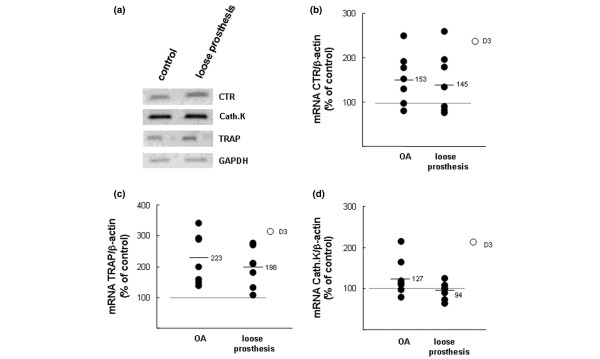Figure 3.

Effects of synovial fluids (SFs) from patients with osteoarthritis (OA) or with a loose prosthesis on the mRNA expressions of the calcitonin receptor (CTR), tartrate-resistant acid phosphatase (TRAP), and cathepsin K (Cath.K) in neonatal mouse calvarial bones. (a) Semi-quantitative reverse transcription-polymerase chain reaction (RT-PCR) analysis on samples obtained by incubating five bones in control medium and five in medium containing SF (10%) from a patient with a loose prosthesis. RNA from the five different bones in each group was pooled and used for RT-PCR analysis. (b) Quantitative real-time PCR analysis of calcitonin receptor (CTR) mRNA in mouse calvarial bones stimulated by SFs from either patients with OA OK or patients with a loose prosthesis. (c) Quantitative real-time PCR analysis of tartrate-resistant acid phosphatase (TRAP) mRNA in mouse calvarial bones stimulated by SFs from either patients with OA OK or patients with a loose prosthesis. (d) Quantitative real-time PCR analysis of cathepsin K (Cath.K) mRNA in mouse calvarial bones stimulated by SFs from either patients with OA OK or patients with a loose prosthesis. In (b-d), data were obtained by incubating one calvarial bone for 48 hours with SF (10%) from an OA patient or with SF (10%) from a patient with a loose prosthesis and the effects were compared to those obtained in unstimulated bones (controls = 100%) or in bones stimulated by D3 (10-8 M). Data shown represent the effects by SFs from seven patients with OA and seven with a loose prosthesis. Effects were compared to the means of two unstimulated bones and two bones treated with D3. At the end of the experiments, RNA was extracted and the mRNA expressions were analysed with quantitative real-time PCR. The mRNA expression of the gene of interest was expressed in relation to that of β-actin, used as a housekeeping gene. D3, 1,25(OH)2-vitamin D3.
